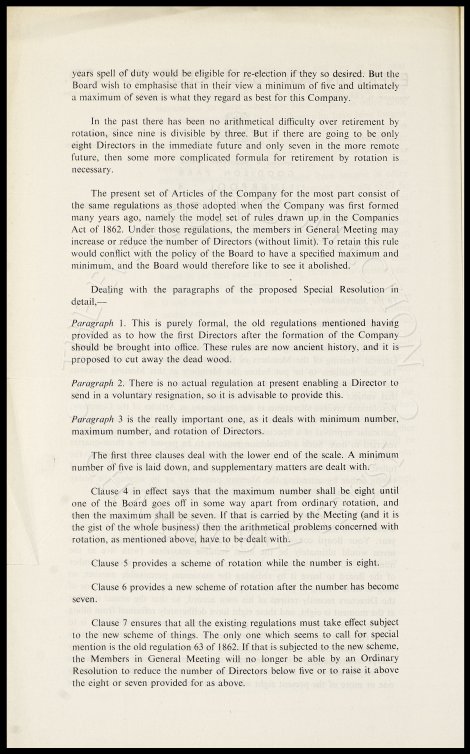
years spell of duty would be eligible for re-election if they so desired. But the Board wish to emphasise that in their view a minimum of five and ultimately a maximum of seven is what they regard as best for this Company. In the past there has been no arithmetical difficulty over retirement by rotation, since nine is divisible by three. But if there are going to be only eight Directors in the immediate future and only seven in the more remote future, then some more complicated formula for retirement by rotation is necessary. The present set of Articles of the Company for the most part consist of the same regulations as those adopted when the Company was first formed many years ago, namely the model set of rules drawn up in the Companies Act of 1862. Under those regulations, the members in General Meeting may increase or reduce the number of Directors (without limit). To retain this rule would conflict with the policy of the Board to have a specified maximum and minimum, and the Board would therefore like to see it abolished. Dealing with the paragraphs of the proposed Special Resolution in detail,— Paragraph 1. This is purely formal, the old regulations mentioned having provided as to how the first Directors after the formation of the Company should be brought into office. These rules are now ancient history, and it is proposed to cut away the dead wood. Paragraph 2. There is no actual regulation at present enabling a Director to send in a voluntary resignation, so it is advisable to provide this. Paragraph 3 is the really important one, as it deals with minimum number, maximum number, and rotation of Directors. The first three clauses deal with the lower end of the scale. A minimum number of five is laid down, and supplementary matters are dealt with. Clause 4 in effect says that the maximum number shall be eight until one of the Board goes off in some way apart from ordinary rotation, and then the maximum shall be seven. If that is carried by the Meeting (and it is the gist of the whole business) then the arithmetical problems concerned with rotation, as mentioned above, have to be dealt with. Clause 5 provides a scheme of rotation while the number is eight. Clause 6 provides a new scheme of rotation after the number has become seven. Clause 7 ensures that all the existing regulations must take effect subject to the new scheme of things. The only one which seems to call for special mention is the old regulation 63 of 1862. if that is subjected to the new scheme, the Members in General Meeting will no longer be able by an Ordinary Resolution to reduce the number of Directors below five or to raise it above the eight or seven provided for as above.
